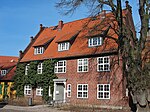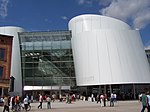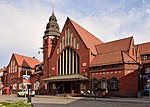St. Nicholas Church, Stralsund
13th-century churches in GermanyBuildings and structures completed in 1279Gothic hall churches in GermanyLutheran churches converted from Roman CatholicismLutheran churches in Mecklenburg-Western Pomerania ... and 1 more
Stralsund

St. Nicholas Church (German: Nikolaikirche) is the oldest of the three major parish churches of the Hanseatic city of Stralsund in Germany. It was dedicated in 1279 to St. Nicholas of Myra, the patron saint of sailors. Since 1524 it has been an Evangelical Lutheran church. It is one of the earliest examples of the introduction of the cathedral pattern of northern France into the Brick Gothic architecture of the Baltic region. As part of the historic centre of Stralsund, St. Nicholas Church was inscribed on the UNESCO World Heritage List in 2002.
Excerpt from the Wikipedia article St. Nicholas Church, Stralsund (License: CC BY-SA 3.0, Authors, Images).St. Nicholas Church, Stralsund
Auf dem St. Nikolaikirchhof,
Geographical coordinates (GPS) Address External links Nearby Places Show on map
Geographical coordinates (GPS)
| Latitude | Longitude |
|---|---|
| N 54.31532 ° | E 13.0912554 ° |
Address
St.-Nikolai-Kirche (Nikolaikirche)
Auf dem St. Nikolaikirchhof 2
18439 , Altstadt
Mecklenburg-Vorpommern, Germany
Open on Google Maps










